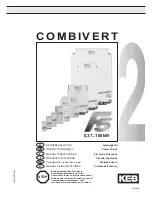
1881M
Installation
3-1
July 23, 1998
3.
Installation
3.1
General Installation
The LeCroy Model 1881M Analog to Digital Converter is intended for use within a FASTBUS crate with
the following voltage sources properly connected to the backplane: +5.0 V, -5.2 V, -2.0 V, +15.0 V, and -
15.0 V. The crate should be an ECL implementation. Each crate must be controlled by a crate master such
as a LeCroy Model 1821 SM /I. Its purpose is to execute standard FASTBUS cycles for control of the
module and transfer of data. A processor interface of some sort is necessary to communicate with the crate.
A LeCroy Model 1821/DEC interface card with either a DEC DR11-W Unibus or a MDB DRV11-2
Qbus parallel I/O board can be used with the DEC computer line. A less expensive way of getting started,
useful for a small number of crates, is to use an IBM PC/AT or compatible with a LeCroy Model 1691A
Interface Card. The 1691A plugs into a slot in the PC and it is connected via a 34 conductor multiwire
cable to the front panel of an 1821 SM /I.
The software package LeCroy Interactive FASTBUS Tool kit (LIFT) is now available for the LeCroy
Model 1691A/IBM PC system providing the user with a substantial package of software to exercise and
test FASTBUS modules using a LeCroy Model 1821 SM /I. LIFT also includes an extensive software
library which the user may employ in the development of user specific data acquisition software.
With either the power on or off, insert the 1881M into one of the slots of the FASTBUS crate. The edge
connector of the module should mate with the bus connector with modest pressure. Note the slot number
of the module, as it will later be used for addressing.
3.1.1
Cables
The optimal method of cabling is the use of coax cables as signal cables. They generally result in decreased
noise pick-up and crosstalk. This is the preferred method of connection, especially for long cable runs.
However, the use of twisted-pair cables generally results in lower cabling costs, and typically higher
density and is usually adequate for digital signals. For this reason the 1881M was designed to accept 34
conductor ribbon cable. If using twisted-pairs, care should be taken to install high quality, shielded cables
to minimize the effects of noise and crosstalk. Many of such cables can be purchased from LeCroy
Corporation. In particular, there are two types of 34 conductor multiwire cables available, one for short
connections using flat cable and the second for long connections using twisted and flat ribbon cable.
The model numbers of such cables are as follows:
STC-DC /34/L - flat multiwire cable for short interconnections
LTC-DC /34-L or DC2 /34-L - twisted-pair multiwire cable for long interconnection.
STP-DC /02-L - single twisted-pair cable, 3 ft maximum length
NOTE that L is the length in feet that must be specified by the user.
One more recent cabling solution that may give very satisfactory results is to use 50
Ω
computer ribbon
cables. they have a copper backing (that must be grounded at one end) and are not differential. These cables
are used with very good results internally in LeCroy for test sets.
All digital inputs are differential ECL and terminated by 102
Ω
. The terminations can be removed by
removing plug in links.
Summary of Contents for 1881M
Page 1: ...MODEL 1881M 64 CHANNEL FASTBUS ADC ...
Page 3: ......
Page 7: ......
Page 27: ......
Page 31: ......














































